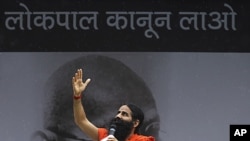India’s politics have been shaken up by high-profile demonstrations against corruption in recent months, many of which have involved fasting. Now, several politically and socially-minded leaders are turning to another method to garner support for their causes.
Yatra, in Hindi, translates simply as "journey." But it is often about much more than getting from one place to another. They are being used to generate influence
Celebrity yoga guru Baba Ramdev became one of the latest Indian public figures to announce his own yatra. He says he will cover 100,000 kilometers of territory in central India's Madhya Pradesh state to fight corruption and call for the return of so-called "black money" to the country from overseas stashes.
Sociologist Dipankar Gupta says yatras are deeply rooted in Indian history.
"A yatra has a religious connotation because it is derived from our mythological texts where sages and saints and sometimes even princes and potentates went on a religious journey, pilgrimage and this journey was called a yatra," said Gupta.
Gupta says it was the genius of Mahatma Gandhi to harness the dignity and simplicity of the yatra to build peaceful resistance to British colonial rule. Staff in hand, one footstep at a time, Gandhi covered massive amounts of territory as his followers increased.
The Mahatma's great grandson, Tushar Gandhi, says yatras have since become more self-interested endeavors.
"Now it's basically a political propaganda tool," he said. "There is no principle involved in that. There is no conviction either. It's just a very, very insincere attempt at manipulating public will. It is done at a drop of a hat without any justification."
October is shaping up to be the month of yatras. Anna Hazare is planning one. In August, the 74-year-old social activist's anti-corruption hunger strike galvanized a mass movement and forced concessions from the central government. Manish Sisodia, a member of his team, acknowledges a yatra is useful for maintaining political momentum.
He says sure, there are yatras for peace and harmony, educating people about their rights, and spreading other kinds of awareness. But, he adds, when you look at large scale yatras, very few have been non-political.
One of the biggest yatras planned for next month is by L.K. Advani, a senior leader of India's main opposition party, the Bharatiya Janata Party. The planned "rath yatra" - meaning Advani will travel in an ornate chariot rather than on foot - aims to convince followers the ruling Congress party coalition has been incapable of taming large-scale corruption. Nirmala Sitharaman, BJP spokeswoman, says yatras offer a unique interpersonal contact.
"It has a immediate connect with the leader and he has a message to give. While that is possible to be given through the print and the electronic media, and nowadays increasingly even through the net-based media, personal connect that you get when you go on a yatra like this is still valued by the Indian public," said Sitharaman.
Prominent ruling party member Rahul Gandhi, widely seen as a likely future prime minister, led his own padhyatra - a journey on foot - in the north Indian state of Uttar Pradesh earlier this year. Many of the other yatras are expected to pass through India's most populous state beginning next month. Uttar Pradesh's 216 million inhabitants go to the polls in next May’s state elections, which are seen as key to gaining control and influence in India's national politics.
Indian Leaders Seek Influence by Taking 'Yatras'











